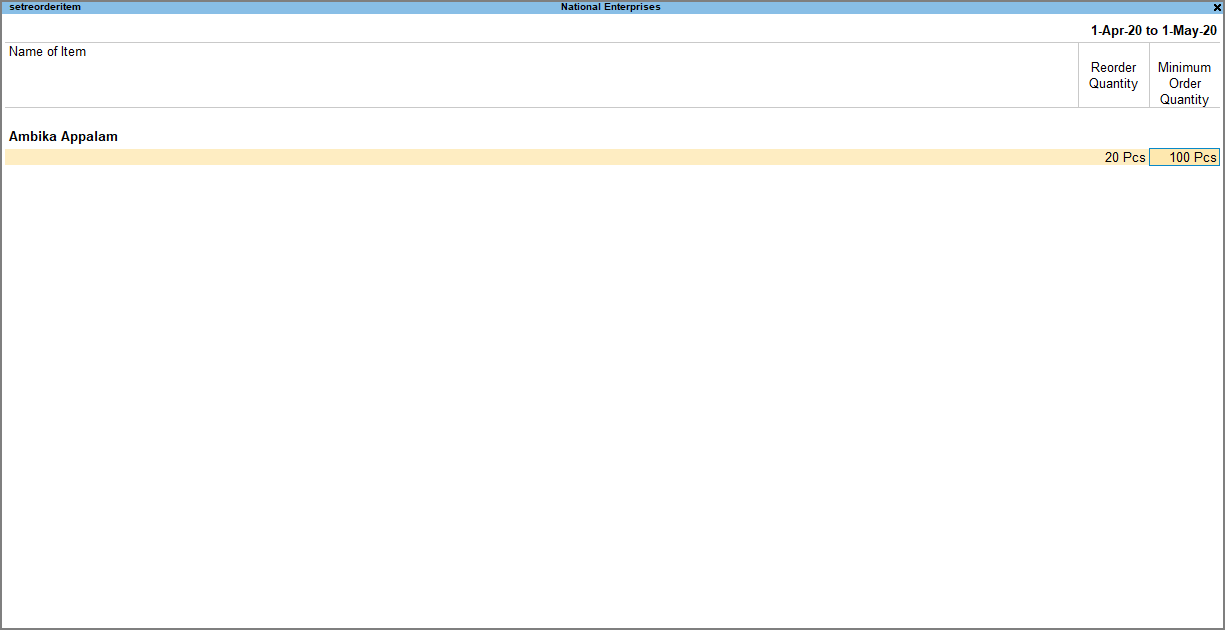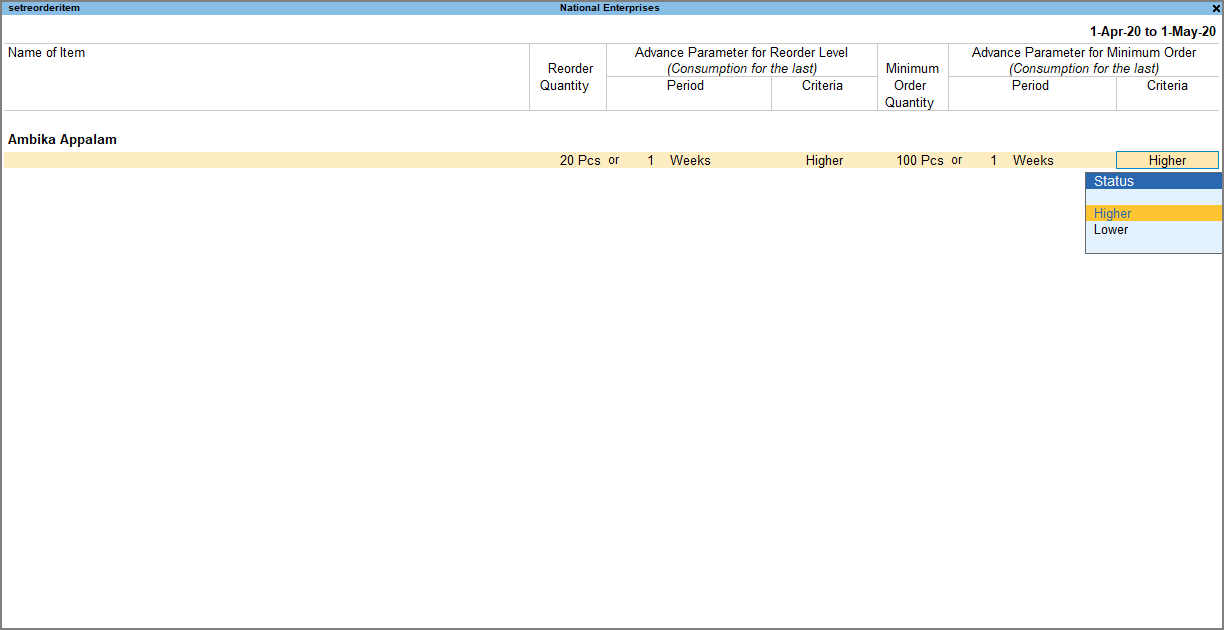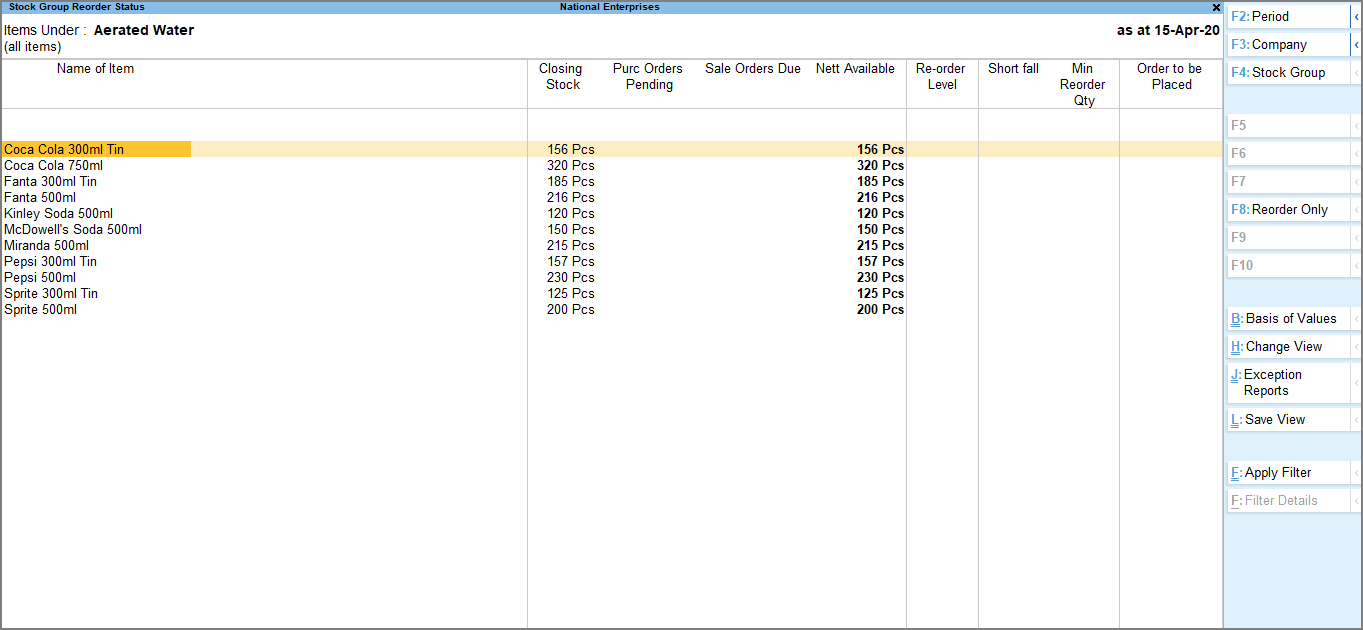Reorder Stock Items
In a business, at any point in time, it is crucial to maintain sufficient stock to meet customers’ demands. TallyPrime has the feature of reorder level which indicates the quantity of stock below which the stocks have to be replenished to refill your inventory. By specifying the Reorder levels and Minimum order quantities in TallyPrime, you can ensure that you never run out of stock again. At the same time, you can also make sure not to accumulate stocks that do not sell.
Your business should also have an ample amount of stock at any given point in time to meet the customer’s demand and never fall short of inventory. In addition, not managing inventory appropriately will affect your cash flow. Consequently, it becomes pivotal to always keep a note of your pending purchase orders, sales orders, and the stock in hand to decide if you have to reorder stocks.
To decide on the reorder levels for stock items, consider the following:
- The lead time for suppliers to deliver the stock
- The delivery time specified by the customers
- The stock-in-hand to satisfy existing orders
Setting the reorder level for your stock items can help you manage your inventory more conveniently.
Manage stock level: In TallyPrime, you can set the Record level for your stock item based on its availability in terms of quantities. However, if you are using stock groups and stock categories, TallyPrime gives you the flexibility to set reorder levels directly on those groups and categories. Based on your requirements, you can set a reorder level to specify the minimum quantity of the stock item in your inventory beyond which a purchase order will be placed to refill your inventory. You will know that there is a shortfall when the quantity of the stock item comes below the reorder level and you should ideally place a purchase order. Similarly, you can set the minimum order quantity, which is the minimum quantity of the stock item you wish to place an order for to optimise the cost and other expenses.
Reorder Status Report: Apart from that, you can also view the actual stock position in the Reorder Status report, and make informed decisions regarding the replenishment of stock items. TallyPrime with its advanced parameter for minimum reorder feature presents a report to you with all the information like purchase order pending, sales order due, shortfall, closing stock, nett available, and so on to assist you in defining the reorder levels. All you have to do is set the criteria of your reorder based on the consumption pattern, set the rounding limits, if any, and you are good to go.
Set Reorder Quantity for Stock Items
TallyPrime gives you the flexibility to set the reorder quantity of your stock item with simple and advanced parameters. In a simple order, you can specify the minimum order quantity (the quantity of stock below which it has to be replenished) and reorder quantity, as per your inventory requirements. Similarly, while setting an advance reorder, you can specify the reorder quantity and minimum order quantity with advance parameters. You can also view the actual stock position in the Reorder Status report, and make the required decisions regarding the stock.
In TallyPrime, you can also set reorder levels for stock groups and stock categories.
You can set advance parameters for minimum order quantity while setting a simple reorder as well.
In this section
Set reorder level and minimum reorder quantity | Simple reorder
Simple Reorder Level is the inventory level at which a company should place an order to replenish its stock. It’s usually calculated based on factors such as lead time (time taken for an order to be delivered), average demand, and desired level of safety stock. For example, if you are into retail, you apply a simple reorder level to ensure that popular products are always in stock. When the inventory level drops to the reorder point due to customer purchases, the business can automatically generate a purchase order to restock those products. Similarly, if you are into manufacturing, you can use the simple reorder feature in Tallyprime to initiate the purchase of raw materials when the inventory of a particular raw material reaches the reorder point to ensure production doesn’t halt due to shortages.
In simple order, you can enter the reorder and minimum advance quantity and set the simple reorder level of stock items. Consequently, once the number of stock items goes below the reorder quantity level, you will be able to see the shortfall in the reorder status report and place an order accordingly. You can also set advance parameters for the minimum quantity based on the consumption pattern of the stock items in a given period.
For example, if the minimum order quantity is set to 100 pcs and the consumption of last week was 65 pcs. If you have enabled lower criteria then the minimum order quantity will be 65 pcs as it is lower than 100. If you have enabled higher criteria then the minimum order quantity will be 100 as it is higher than 65.
- Open the reorder level master for the required stock item/stock group/stock category.
- Press Alt+G (Go To) > Alter Master > type or select Reorder Level (Stock Item) > and press Enter.
Alternatively, Gateway of Tally > Alter > type or select Reorder Level (Stock Item) > and press Enter. - Select the stock item.
If you have created stock groups or stock categories, you can select Reorder Level (Stock Group) or Reorder Level (Stock Category). The stock items created under the stock group/category will appear.
- Press Alt+G (Go To) > Alter Master > type or select Reorder Level (Stock Item) > and press Enter.
- Configure the screen for simple reorder with simple minimum quantity or advance minimum quantity.
The default screen will be of advance reorder with advance minimum quantity.
- Press Alt+S (Simple Reorder) to enable simple reorder.
- Press Alt+V (Simple Min Qty) to enable simple minimum quantity.
- Enter the reorder quantity and minimum order quantity.
- Enter the Reorder Quantity, which is the minimum amount of the stock item you wish to keep on hand.
- Enter the Minimum Order Quantity, which is the minimum quantity of the stock item you wish to order.

If you have opted for advance minimum quantity, you can enter the following details as well along with reorder quantity and minimum reorder quantity.
- Period: You can select the consumption for various periods – Days, Weeks, Months or Years. This is the total consumption for the selected period (not the average consumption).
Enter 0 (zero), if you do not want to calculate the reorder level based on the consumption in the past. - Criteria: You can select Higher or Lower based on the consumption (as per reorder quantity or the period specified).

Now, the reorder will be placed either according to the number set under Minimum Order Quantity, or the Higher or Lower of the consumption under Period.
- Period: You can select the consumption for various periods – Days, Weeks, Months or Years. This is the total consumption for the selected period (not the average consumption).
- As always, press Ctrl+A to save the screen.
Now, if your available stock falls below the set reorder quantity, it will be visible in the reorder status report to assist you in placing an order as required.
To view the details of reorder status and quantity, refer to Reorder Status report.
Set advance reorder level and advance minimum reorder quantity | Advance reorder
As the name suggests, advance reorder level is an advanced feature that takes into account factors like order quantity, stock consumption of a particular period, and order costs to determine the optimal quantity to reorder. It amplifies the balance between holding too much inventory (incurring storage costs and also blocking capital) and ordering too frequently (incurring high ordering costs). For example, if you have limited storage space in your businesses, using the advance reorder feature in TallyPrime helps ensure that only the most necessary quantities are kept in stock, preventing excess stock from occupying valuable space. This can further minimise total inventory costs by considering factors like holding costs and ordering costs including processing, transportation, and so on.
In advance order, you can set advance parameters for both the reorder and minimum advance quantity based on the consumption pattern of the stock items in a given period. You can also set rounding limits to the reorder level.
For example, if the reorder quantity is set to 20 pcs and the consumption of last week was 65 pcs. If you have enabled higher criteria then reorder quantity will be 65 pcs as it is higher than 20. If you have enabled lower criteria then the reorder quantity will be 20 as it is lower than 65.
Similarly, if the minimum order quantity is set to 100 pcs and the consumption of last week was 65 pcs. If you have enabled higher criteria then reorder will be 100 pcs as it is higher than 65. If you have enabled lower criteria then the minimum order quantity will be 65 as it is lower than 100.
- Open the reorder level master for the required stock item/stock group/stock category.
- Press Alt+G (Go To) > Alter Master > type or select Reorder Level (Stock Item) > and press Enter.
Alternatively, Gateway of Tally > Alter > type or select Reorder Level (Stock Item) > and press Enter. - Select the stock item.
If you have created stock groups or stock categories, you can select Reorder Level (Stock Group) or Reorder Level (Stock Category). The stock items created under the stock group/category will appear.
- Press Alt+G (Go To) > Alter Master > type or select Reorder Level (Stock Item) > and press Enter.
- Configure the screen for advance reorder with simple minimum quantity or advance minimum quantity.
- Press Alt+S (Adv Reorder) to enable advance reorder options, if not enabled.
- Press Alt+V (Adv Min Qty) to enable the advanced parameters for minimum quantity, if not enabled.
- Specify the Reorder Quantity with advanced parameters.
- Enter the stock item’s Reorder Quantity, which is the minimum amount of the stock item you wish to keep on hand.
- Period: Select the consumption for various periods – Days, Weeks, Months, or Years.
This is the total consumption for the selected period (not the average consumption).
Enter 0 (zero), if you do not want to calculate the reorder level based on the consumption in the past. - Criteria: Select Higher or Lower based on the consumption (as per reorder quantity or the period specified).
Now, the reorder quantity will be taken either according to the number set under Reorder Quantity, or the Higher or Lower of the consumption under Period.
- Enter the Minimum Order Quantity, which is the minimum quantity of the stock item you wish to order.
- Enter the quantity of the stock item you want to set as the Minimum Order Quantity.
- The Advance Parameters for Reorder Level help in the calculation of quantity to be reordered, based on the total consumption in the past for a given period.
- Period: You can select the consumption for various periods – Days, Weeks, Months, or Years. This is the total consumption for the selected period (not the average consumption). Enter 0 (zero), if you do not want to calculate the reorder level based on the consumption in the past.
- Criteria: You can select Higher or Lower based on the consumption (as per reorder quantity or the period specified).
Now, the reorder will be placed either according to the number set under Minimum Order Quantity, or the Higher or Lower of the consumption under Period.

- As always, press Ctrl+A to save the screen.
Now, if your available stock falls below the set reorder quantity configured with the advanced parameters set by you, it will be visible in the reorder status report to assist you in placing an order as required.
To view the details of reorder status and quantity, refer to Reorder Status report.
Reorder Status of Stock Items/Stock Groups/Stock Categories
You can use the Reorder Status report to check the nett available stock, based on the pending purchase and sales orders. Once you define the Reorder Quantity and Minimum Order Quantity for the stock items, this report will display the quantity to be ordered and the shortfall, if any. When you drill down from the columns of this report, you can get complete insights about the inventory position. from the various inventory reports and reorder level details. You can use this report to make the required analysis related to the movement of your inventory.
- Press Alt+G (Go To) > type Reorder Status > and select the reorder status report for stock group or stock category.
Alternatively, Gateway of Tally > Display More Reports > Statement of Inventory > Reorder Status > select Stock Group or Stock Category.
By default, all the stock items of the selected stock group or stock category appears. To view only those stock items which need to be reordered, press F8 (Reorder Only) or Ctrl+B (Basis of Values) > Reorder Only.

- Name of Item: Displays the list of stock items that belong to the selected stock group or stock category. Place the cursor on the item name, and press Enter. The Item Movement Analysis report appears with the details of inward movement of the stock item. You can further drill down to the Item Voucher Analysis report, and then to the voucher. For more information, refer to Movement Analysis.
- Closing Stock: Displays the closing balance of the stock item for the date on which the report is generated. Place the cursor on the quantity displayed in this column, and press Enter. The Stock Item Monthly Summary appears, with the details of inward, outward and closing balance of the selected stock item. You can further drill down to the Stock Item Vouchers report, and then to the voucher.
- Purc Orders Pending: Displays the total quantity of stock item pending to be received from the purchase orders. Place the cursor on the quantity displayed in this column, and press Enter. The Order Details report appears with the details of outstanding purchase orders. You can select the transactions under any of the pending orders and press Enter, to view the voucher.
- Sales Orders Due: Displays the total quantity of stock item due for sales based on the sales orders raised. Place the cursor on the quantity displayed in this column, and press Enter. The Order Details report appears with the details of outstanding sales orders. You can select the transactions under any of the pending orders and press Enter, to view the voucher.
- Nett Available: Displays the stock available for each stock item after considering the purchase orders and sales orders. It is basically derived from adding the pending purchase order to the closing stock and minusing the sales order.
- Re-order Level: The value here is based on the consumption pattern set for the Reorder Quantity and Minimum Order Quantity in the Specify Reorder Levels screen. Place the cursor on the quantity displayed in this column, and press Enter. The Specify Reorder Levels screen appears.
- Shortfall: Only when the quantity in Re-order Level column is more than the Nett Available column, the difference appears as Shortfall. If the shortfall is equal to or greater than the minimum order quantity, then we should ideally place a purchase order.
- Min Order Quantity: It is the minimum quantity of the stock item you wish to order. Its value on this report is based on the minimum quantity set as per the consumption pattern in the Specify Reorder Levels screen. Place the cursor on the quantity displayed in this column, and press Enter. The Specify Reorder Levels screen appears.
- Order to be Placed: This depends on the shortfall and the minimum order quantity.
- When the Shortfall is more than the Min Order Quantity, the quantity displayed in Shortfall column appears under Order to be Placed.
- When the Shortfall is less than the Min Order Quantity, the quantity displayed in Min Order Quantity appears under Order to be Placed.
To change the display name for the Name of Item, press F12 (Configure), and select the required display name.
You can also further configure the report,
- Press F4 (Stock Group) to select a different stock group.
- Press Ctrl+J (Exception Reports) to view details of negative stock items.
- Press Ctrl+H (Change View) to view the Monthly Summary, Movement Analysis, Ageing Analysis, and so on.
To know more, refer to the Working with Reports in TallyPrime topic.



